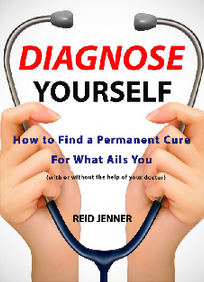This is a guest post by Reid Jenner, an acclaimed naturopathic problem-solving specialist:
 These days, the typical doctor’s office (or hospital emergency room) is busier than ever, often at the expense of quality care for patients. Healthcare providers, who see increasingly more patients in a day and have less time to spend with each one, often conduct rushed, superficial medical exams and have limited dialogue with their patients. A recent study found that the average initial patient examination only lasts a little more than nine minutes[1], most often resulting in a quick prescription to treat observed symptoms or in scheduling another appointment to conduct more tests. With such cursory visits, a correct diagnosis of the underlying cause of the patient’s health concerns is frequently overlooked or delayed. As a result, patient suffering is frequently prolonged until the source of the problem can finally be pinpointed and properly treated.
These days, the typical doctor’s office (or hospital emergency room) is busier than ever, often at the expense of quality care for patients. Healthcare providers, who see increasingly more patients in a day and have less time to spend with each one, often conduct rushed, superficial medical exams and have limited dialogue with their patients. A recent study found that the average initial patient examination only lasts a little more than nine minutes[1], most often resulting in a quick prescription to treat observed symptoms or in scheduling another appointment to conduct more tests. With such cursory visits, a correct diagnosis of the underlying cause of the patient’s health concerns is frequently overlooked or delayed. As a result, patient suffering is frequently prolonged until the source of the problem can finally be pinpointed and properly treated.
10 Ways To Be Your Own Health Advocate in the New Year
The good news is that most patients are equipped with the essential tools to take more responsibility for their own health. Here are 10 ways to help yourself and your health care provider reach faster, more effective, and less invasive personal health management outcomes:
- Record the relevant facts associated with your illness prior to meeting with your doctor. Studies show that most illnesses are not caused by genetic or internal defects[2]; they have an external or environmental trigger—usually related to factors like diet, lifestyle changes, or an exposure to some kind of toxin or irritant. This is information not typically provided on patient history forms, nor information your doctor will necessarily probe for in the short initial examination. Take notes of big changes in what you eat, as well as where and how you live.
- Keep a log of your symptom expression and development. When and where were you when you first experienced your symptoms? Were you doing anything differently in your life just before the symptoms began? How have the symptoms changed over time? Do they improve or worsen with specific activities? Where exactly are your symptoms being experienced in your body, and where are they not?
- Focus on the unique attributes of your specific illness and your unique circumstances. Identify people with similar lifestyle, location, and habits who are NOT experiencing the same health problems. What you are doing or have done differently? Epidemiologists use this technique very effectively to pinpoint the cause of serious outbreaks. Most illnesses can be traced to something unique about your special habits, your unique location, or the unique timing of your illness.
- Formulate many hypotheses for your illness. Think outside the box—don’t just limit yourself to the obvious sources. Use the information you’ve uncovered in the first three steps to imagine any potential source for your malady. Casting a wide net with the right information filters increases the chance of finding the needle in the haystack that many health care professionals don’t have the time or tools to uncover by themselves.
 Be specific in articulating the trigger mechanism for your illness. Don’t just say ‘dietary changes’. I once had a client whose cause of very painful kidney stones was eventually traced to “30-pound weight gain over the holidays, followed by equally rapid weight loss the following month.”
Be specific in articulating the trigger mechanism for your illness. Don’t just say ‘dietary changes’. I once had a client whose cause of very painful kidney stones was eventually traced to “30-pound weight gain over the holidays, followed by equally rapid weight loss the following month.”
- Test each hypothesis against the facts. This isn’t as hard as it sounds—simply find one relevant and supportable fact to rule out each non-viable cause of your illness. Another client of mine was able to conclusively rule out allergy to pet dander as the cause of his debilitating and recurring sinus infections (one of his doctor’s favorite suspects) by tracing the onset and recurrence of his symptoms to the use of a new wood stove in his house, and not to his recurring exposure to his dogs.
- Narrow the possible sources of your illness to a most probable cause. The most probable cause is the one that requires the fewest assumptions and explanations to explain the facts of the problem—who the illness is affecting, where you are when it is expressing, where on your body it is expressing, when exactly the symptoms express, etc. Most causes will be ruled out against one or more of these facts, and the weaker possibilities will require less plausible explanations to fit the facts.
- Summarize and present your findings at the outset of your doctor visit. Don’t let your doctor just start to automatically examine you with various instruments, tests and palpations. Engage in verbal discourse early: tell the doctor what you’ve uncovered and what you think may be causing the problem. Put the onus on the doctor to evaluate and rule out your probable hypotheses.
- Question alternative diagnoses suggested by your doctor. Use the same critical thinking process you used to analyze your problem to evaluate and rule out implausible reasons for your illness. Doctors are far from perfect diagnosticians—autopsies reveal 20 percent or more of serious illnesses were improperly diagnosed[3].
- Defend your body—be your own advocate. It’s your body, so take responsibility for what happens to it. Don’t let your doctor invade the sanctity of your body by conducting intrusive tests, performing invasive procedures or prescribing heavy-duty medication with potentially heavy-duty side effects unless you can support the need for these procedures based on the facts you’ve already gleaned. Information is power—and you are the primary custodian of the critical information relating to your health! Use that power wisely and gather your information from knowledgeable and trusted sources.
References
[1] “Time Spent in Face-to-Face Patient Care and Work Outside the Examination Room”, by Andrew Gottschalk and Susan A. Flock, Annals of Family Medicine, November 2005; 3(6): 488-493
[2] “Stop Blaming Your Genes”, by Sharon Begley, Newsweek, July 24, 2000, Vol 136, Issue 4
AUTHOR BIO
 Reid Jenner is an acclaimed naturopathic problem-solving specialist with more than 20 years experience designing, teaching, and facilitating root-cause analysis techniques in the health sector, He has successfully solved hundreds of health problems for clients with a wide range of maladies. He is passionately focused on helping every patient use his or her personal health history to find the quickest, simplest, and least invasive permanent solution to each problem. In his experience, the vast majority of intractable problems can be solved in 60-120 minutes. His recently published book Diagnose Yourself: Place the Power of Healing in Your Hands. Diagnose Yourself outlines the process by which individuals can take more responsibility for their diagnosis and overall health management.
Reid Jenner is an acclaimed naturopathic problem-solving specialist with more than 20 years experience designing, teaching, and facilitating root-cause analysis techniques in the health sector, He has successfully solved hundreds of health problems for clients with a wide range of maladies. He is passionately focused on helping every patient use his or her personal health history to find the quickest, simplest, and least invasive permanent solution to each problem. In his experience, the vast majority of intractable problems can be solved in 60-120 minutes. His recently published book Diagnose Yourself: Place the Power of Healing in Your Hands. Diagnose Yourself outlines the process by which individuals can take more responsibility for their diagnosis and overall health management.
[…] (very modestly) profitable this past year. I’m very proud to have contributed to awareness and advocacy for multiple health conditions. I have thoroughly enjoyed interviewing an array of experts and […]